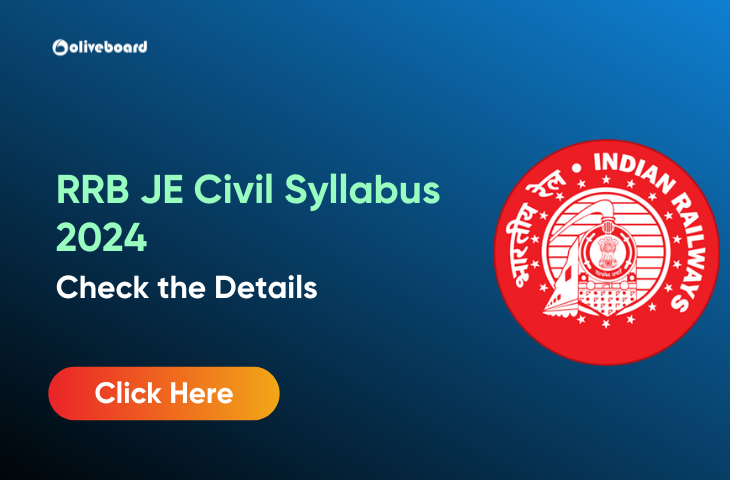The Railway Recruitment Board (RRB) has announced the RRB JE 2024 Notification to fill 7,951 vacancies. Candidates can find all the essential details about the RRB JE Civil Syllabus 2024 in this article.
RRB JE Civil Syllabus 2024
The RRB JE Civil Syllabus 2024 outlines the key topics that candidates must study for the Junior Engineer (JE) Civil exam conducted by the Railway Recruitment Board (RRB). This exam assesses your understanding of civil engineering subjects relevant to roles like Junior Engineer (JE), Junior Engineer in Information Technology, Depot Material Superintendent (DMS), and Chemical & Metallurgical Assistant (CMA). A thorough knowledge of the syllabus is essential for effective preparation and success in the exam.
RRB JE Civil Syllabus – Overview
We have provided a basic overview of RRB JE Recruitment 2024 in the below table for the ease of candidates.
| Particulars | Details |
| Board | Railway Recruitment Board (RRBs) |
| Exam Name | RRB JE 2024 |
| Vacancies | 7951 posts |
| Name of the Posts | Junior Engineer (JE), Junior Engineer (IT), Depot Materials Superintendent (DMS), Chemical & Metallurgical Assistant (CMA) |
| No. of Questions | CBT 1: 100 CBT 2: 150 |
| Duration | CBT 1: 90 minutes CBT 2: 120 minutes |
| Marking Scheme | 1 mark |
| Negative Marking | ⅓ mark |
| Selection Process | – First Stage of CBT – Second Stage of CBT – Document Verification – Medical Examination |
| Official Website | indianrailways.gov.in |
RRB JE CE Syllabus 2024
Here are the key topics included in the RRB JE Civil Syllabus 2024. For candidates specializing in Civil Engineering, Paper 2 will feature questions solely from this syllabus. The detailed RRB JE Civil Syllabus 2024 is provided below:
| Name of Subjects | Name of Topics |
| Engineering Mechanics | Force (resolution of force, moment of force, force system, composition of forces), Equilibrium, Friction, Centroid and Center of gravity, Simple machines. Building components (substructure, superstructure), type of structure (load bearing, framed and composite structures). |
| Building Materials | Masonry materials (stones, bricks, and mortars), Timber, and miscellaneous materials (glass, plastic, fiber, aluminum steel, galvanized iron, bitumen, PVC, CPVC, and PPF). |
| Construction of Substructure | Job layout, earthwork, foundation (types, dewatering, cofferdams, bearing capacity). |
| Construction of Superstructure | Stone masonry, brick masonry, Hollow concrete block masonry, composite masonry, cavity wall, doors and windows, vertical communication (stairs, lifts, escalators), scaffolding, and shoring. |
| Building Finishes | Floors (finishes, process of laying), walls (plastering, pointing, painting), and roofs (roofing materials including RCC). |
| Building Maintenance | Cracks (causes, type, repairs- grouting, uniting, epoxy, etc.), settlement (causes and remedial measures), and re-baring techniques. |
| Building Drawing | Conventions (type of lines, symbols), planning of building (principles of planning for residential and public buildings, rules and bylaws), drawings (plan, elevation, section, site plan, location plan, foundation plan, working drawing), perspective drawing. |
| Concrete Technology | Properties of various types/grades of cement, properties of coarse and fine aggregates, properties of concrete (water-cement ratio, properties of fresh and hardened concrete), Concrete mix design, testing of concrete, quality control of concrete (batching, formwork). |
| Surveying | Types of survey, chain and cross staff survey, compass survey, leveling, contouring, area and volume measurements, plane table survey, theodolite survey, Tacheometric survey, curves, advanced survey equipment, aerial survey, and remote sensing. |
| Computer-Aided Design | CAD Software (AutoCAD, Auto Civil, 3D Max, etc.), CAD commands, generation of the plan, elevation, section, site plan, area statement, and 3D view. |
| Geo-Technical Engineering | Application of Geo-Technical Engineering in design, physical properties of soil, permeability of soil and seepage analysis, shear strength of soil, bearing capacity of soil, compaction and stabilization of soil, site investigation, and subsoil exploration. |
| Hydraulics | Properties of fluid, hydrostatic pressure, measurement of liquid pressure in pipes, fundamentals of fluid flow, flow of liquid through pipes, flow through open channels, flow measuring devices, and hydraulic machines. |
| Irrigation Engineering | Hydrology, investigation, and reservoir planning, percolation tanks, diversion headworks. |
| Mechanics of Structures | Stress and strain, shear force and bending moment, moment of inertia, stresses in beams, analysis of trusses, strain energy. |
| Theory of Structures | Direct and bending stresses, slope and deflection, fixed beam, continuous beam, moment distribution method, columns. |
| Design of Concrete Structures | Working Stress method, Limit State method, analysis, and design of singly reinforced and doubly reinforced sections, shear, bond and development length, analysis and design of T Beam, slab, axially loaded column, and footings. |
| Design of Steel Structures | Types of sections, grades of steel, strength characteristics, IS Code, Connections, Design of tension and compression members, steel roof truss, beams, and column bases. |
| Transportation Engineering | Railway Engineering (alignment and gauges, permanent way, railway track geometrics, branching of tracks, stations and yards, track maintenance), Bridge engineering, Tunnel engineering. |
| Highway Engineering | Road Engineering, investigation for road projects, geometric design of highways, construction of road pavements and materials, traffic engineering, hill roads, drainage of roads, maintenance, and repair of roads. |
| Environmental Engineering | Environmental pollution and control, public water supply, domestic sewage, solid waste management, environmental sanitation, and plumbing. |
| Advanced Construction Techniques and Equipment | Fibers and plastics, artificial timber, advanced concreting methods, formwork, prefabricated construction, soil reinforcing techniques, hoisting and conveying equipment, earth-moving machinery, concrete mixers, stone crushers, pile driving equipment. |
| Estimating and Costing | Types of estimates (approximate, detailed), mode of measurements, and rate analysis. |
| Contracts and Accounts | Types of engineering contracts, Tender and tender documents, payment, and specifications. |
This blog aims to provide comprehensive insights into the RRB JE Civil Syllabus 2024. For more informative articles, visit the Oliveboard website!
RRB JE Civil Syllabus 2024 – FAQs
The main subjects include Engineering Mechanics, Building Materials, Construction of Substructure, Construction of Superstructure, Concrete Technology, Surveying, Geo-Technical Engineering, Hydraulics, Mechanics of Structures, Theory of Structures, Design of Concrete Structures, and more.
Yes, the syllabus covers Building Drawing, including conventions, planning of buildings, drawing plans, elevations, sections, site plans, location plans, foundation plans, and perspective drawings.
Yes, Surveying is an important part of the syllabus, covering chain and cross-staff survey, compass survey, leveling, contouring, plane table survey, theodolite survey, Tacheometric survey, and advanced surveying equipment.
Yes, Computer-Aided Design (CAD) is part of the syllabus, focusing on CAD software like AutoCAD and commands for generating plans, elevations, sections, site plans, and 3D views.
Yes, Environmental Engineering is included, covering environmental pollution and control, public water supply, domestic sewage, solid waste management, environmental sanitation, and plumbing.
Engineering Mechanics includes topics like force, equilibrium, friction, centroid and center of gravity, simple machines, building components, and types of structures.
Yes, the syllabus includes Advanced Construction Techniques and Equipment, covering fibers and plastics, artificial timber, advanced concreting methods, formwork, prefabricated construction, and construction machinery.
Yes, Geo-Technical Engineering is part of the syllabus, including the design of foundations, physical properties of soil, permeability, shear strength, compaction, and soil stabilization.
The Design of Concrete Structures covers working stress and limit state methods, analysis, and design of singly and doubly reinforced sections, T-beams, slabs, columns, and footings.
Yes, the syllabus includes Estimating and Costing, as well as Contracts and Accounts, covering types of estimates, mode of measurements, rate analysis, engineering contracts, tender documents, and payment specifications.
- RRB NTPC General Awareness Preparation, Check Study Plan

- RRB NTPC Answer Key 2025 Out, Check CBT Response Sheet

- Railway Govt Jobs 2025, Latest RRB, RPF Recruitment Exams

- RRB NTPC Practice Questions, Solve Mock Questions for CBT

- Number Series Questions for RRB NTPC Exam, Check Details

- Elementary Algebra for RRB NTPC | Preparation Tips & Practice Questions


